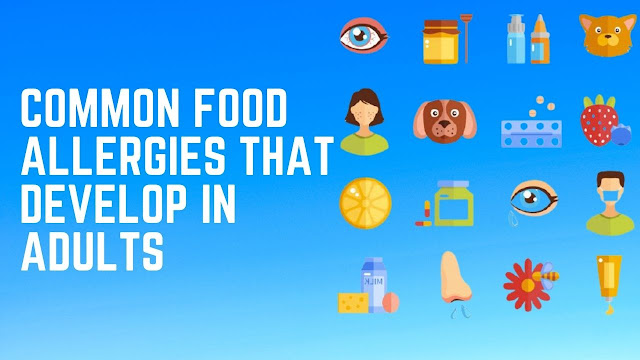 |
| Common Food Allergies That Develop In Adults |
How To Fight For Common Food Allergies That Develop In Adults
Food allergy is one of the kinds of food reactions caused by the food itself, which suggests that it is not overreacting to the immune system of the body. In food allergy, the human body develops IgE antibodies to multiple epitopes in the allergens.
There are also different food allergies that arise in adults, but these are the most frequently diagnosed food allergies in the United States currently., but these are the most frequently diagnosed food allergies in the United States currently.
Allergy To Wheat
Wheat plays a big role in all of our diets, being the basis for some breakfast cereals, spaghetti, and pizza, and you can also use it in food products like soups and snack bars.As an ingredient, it has a wide variety of uses, which can make it very difficult to avoid at first if you are intolerant of wheat, but it can make things much easier to do a little research and learn what to look for on food labels.
Allergy to Peanuts
Peanuts have a bad reputation when it comes to allergies and it's easy to see why. Allergic reactions to peanuts or peanut-related items can be extreme and maybe even deadly if not dealt with in time. In certain people, even small doses of peanuts can induce a reaction, and peanuts can find their way into a wide variety of everyday items such as some foods described above. Chocolate, candy bars, and peanut butter are more evident, but there are also some pastries and even ice cream.
Allergy to Milk
This is the most common of all food allergies that normally manifests early on in a child's existence. The justification for this is that children drink more milk at an early stage than adults. Although there can be a very extreme reaction to a milk allergy, most people mature out of it as they pass into maturity.
Allergy to Food
In the supermarket, eggs can contain allergens that are difficult to avoid and can be very serious. Both the egg white and the egg yolk can trigger an allergic reaction.
Shellfish Allergy
Shellfish allergies in adults are more common than in infants. In about 2 percent of adults, an allergic reaction to shellfish occurs, and it usually occurs in early adulthood.
Allergy of Soybeans
There is a strong relation with being a member of the soybean and peanut legume family. When egg allergies began to come to the fore, in the 1950s and 60s, soy was considered safer than milk in baby food products. And because it's protein-rich, soy is used as an ingredient in many household food products today.
Tree Nuts Allergy
Although nuts such as pistachios, Brazilian nuts, pines, and almonds all come from trees and peanuts come from the ground, as tree nuts are also allergic to a large number of people who are allergic to peanuts, there seems to be a correlation there. If a person has an allergic reaction to any type, it is best to avoid nuts altogether.
How Can Common Food Allergies That Develop In Adults
Food Allergies vs Food Allergy
It is also not properly diagnosed if, relative to a person who is allergic to a certain food, you are simply unable to consume those foods or liquids. As you are born with a food allergy, it is not as likely that adults may develop food allergies. A food allergy is much more complex than a deficiency, as food aversion usually obscures similar symptoms of an allergy. When intolerance creates toxic by-products and histamine, food aversion imitates a food allergy inside the body, which in turn will lead you to believe that you are actually allergic to a food, but that you are merely intolerant to it.
Popular and Common Food Allergies That Develop In Adults
The quantity and severity of any of the more frequent allergic reactions are different across the digestive tract, working their way up. Some of the usual symptoms may begin with the tingling, or numbness, of your lips and mouth. The route of the allergen running down the digestive tract can cause symptoms in the same manner, with stomach cramping and an irritated digestive system. When the allergen finds its way into the bloodstream, the effects can range from rashes to hives. Adults can suffer from anaphylaxis, where the blood pressure of a person decreases leading to swelling of their tongue and throat, for those suffering from a serious bloodstream reaction. This will eventually stop the airflow from hitting the lungs, contributing to the untimely death of the human.
Concealed Meat Allergens Everywhere
Food allergies for adults may be a concern for those who suffer from the allergen itself, as the introduction of the allergen may not reveal itself until the patient actually eats what they suffer from. As there is no existing cure for those suffering from a food allergy, the sufferer can easily stop the foods of which he has the reactions by modifying their diet to exclude certain foods.
Since childhood, adults are unable to develop food allergies because they are more than likely to suffer from food intolerance. Food immunity is more closely linked to a probable range of offending foods that induce digestive issues, whereas food aversion has distinctive effects and is caused by an adverse reaction to a single food protein.














0 Comments